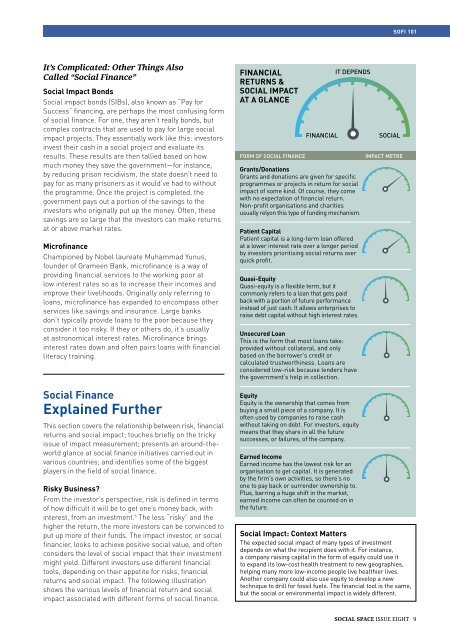Social Space (Issue 8, 2016-2017) - The Social Finance Issue
Since its debut in 2008, Social Space, the bi-annual flagship publication of the Lien Centre for Social Innovation at Singapore Management University, has provided a platform for local and international practitioners and thought leaders to share their perspectives on social innovation and entrepreneurship. Available in print and online (http://www.socialspacemag.org).
Since its debut in 2008, Social Space, the bi-annual flagship publication of the Lien Centre for Social Innovation at Singapore Management University, has provided a platform for local and international practitioners and thought leaders to share their perspectives on social innovation and entrepreneurship. Available in print and online (http://www.socialspacemag.org).
Create successful ePaper yourself
Turn your PDF publications into a flip-book with our unique Google optimized e-Paper software.
SoFi 101<br />
It’s Complicated: Other Things Also<br />
Called “<strong>Social</strong> <strong>Finance</strong>”<br />
<strong>Social</strong> Impact Bonds<br />
<strong>Social</strong> impact bonds (SIBs), also known as “Pay for<br />
Success” financing, are perhaps the most confusing form<br />
of social finance. For one, they aren’t really bonds, but<br />
complex contracts that are used to pay for large social<br />
impact projects. <strong>The</strong>y essentially work like this: investors<br />
invest their cash in a social project and evaluate its<br />
results. <strong>The</strong>se results are then tallied based on how<br />
much money they save the government—for instance,<br />
by reducing prison recidivism, the state doesn’t need to<br />
pay for as many prisoners as it would’ve had to without<br />
the programme. Once the project is completed, the<br />
government pays out a portion of the savings to the<br />
investors who originally put up the money. Often, these<br />
savings are so large that the investors can make returns<br />
at or above market rates.<br />
Microfinance<br />
Championed by Nobel laureate Muhammad Yunus,<br />
founder of Grameen Bank, microfinance is a way of<br />
providing financial services to the working poor at<br />
low interest rates so as to increase their incomes and<br />
improve their livelihoods. Originally only referring to<br />
loans, microfinance has expanded to encompass other<br />
services like savings and insurance. Large banks<br />
don’t typically provide loans to the poor because they<br />
consider it too risky. If they or others do, it’s usually<br />
at astronomical interest rates. Microfinance brings<br />
interest rates down and often pairs loans with financial<br />
literacy training.<br />
<strong>Social</strong> <strong>Finance</strong><br />
Explained Further<br />
This section covers the relationship between risk, financial<br />
returns and social impact; touches briefly on the tricky<br />
issue of impact measurement; presents an around-theworld<br />
glance at social finance initiatives carried out in<br />
various countries; and identifies some of the biggest<br />
players in the field of social finance.<br />
Risky Business?<br />
From the investor’s perspective, risk is defined in terms<br />
of how difficult it will be to get one’s money back, with<br />
interest, from an investment. 5 <strong>The</strong> less “risky” and the<br />
higher the return, the more investors can be convinced to<br />
put up more of their funds. <strong>The</strong> impact investor, or social<br />
financier, looks to achieve positive social value, and often<br />
considers the level of social impact that their investment<br />
might yield. Different investors use different financial<br />
tools, depending on their appetite for risks, financial<br />
returns and social impact. <strong>The</strong> following illustration<br />
shows the various levels of financial return and social<br />
impact associated with different forms of social finance.<br />
FINANCIAL<br />
RETURNS &<br />
SOCIAL IMPACT<br />
AT A GLANCE<br />
Form of <strong>Social</strong> <strong>Finance</strong><br />
FINANCIAL<br />
It depends<br />
Grants/Donations<br />
Grants and donations are given for specific<br />
programmes or projects in return for social<br />
impact of some kind. Of course, they come<br />
with no expectation of financial return.<br />
Non-profit organisations and charities<br />
usually relyon this type of funding mechanism.<br />
Patient Capital<br />
Patient capital is a long-term loan offered<br />
at a lower interest rate over a longer period<br />
by investors prioritising social returns over<br />
quick profit.<br />
Quasi-Equity<br />
Quasi-equity is a flexible term, but it<br />
commonly refers to a loan that gets paid<br />
back with a portion of future performance<br />
instead of just cash. It allows enterprises to<br />
raise debt capital without high interest rates.<br />
Unsecured Loan<br />
This is the form that most loans take:<br />
provided without collateral, and only<br />
based on the borrower’s credit or<br />
calculated trustworthiness. Loans are<br />
considered low-risk because lenders have<br />
the government’s help in collection.<br />
Equity<br />
Equity is the ownership that comes from<br />
buying a small piece of a company. It is<br />
often used by companies to raise cash<br />
without taking on debt. For investors, equity<br />
means that they share in all the future<br />
successes, or failures, of the company.<br />
Earned Income<br />
Earned income has the lowest risk for an<br />
organisation to get capital. It is generated<br />
by the firm’s own activities, so there’s no<br />
one to pay back or surrender ownership to.<br />
Plus, barring a huge shift in the market,<br />
earned income can often be counted on in<br />
the future.<br />
SOCIAL<br />
IMPACT METRE<br />
<strong>Social</strong> Impact: Context Matters<br />
<strong>The</strong> expected social impact of many types of investment<br />
depends on what the recipient does with it. For instance,<br />
a company raising capital in the form of equity could use it<br />
to expand its low-cost health treatment to new geographies,<br />
helping many more low-income people live healthier lives.<br />
Another company could also use equity to develop a new<br />
technique to drill for fossil fuels. <strong>The</strong> financial tool is the same,<br />
but the social or environmental impact is widely different.<br />
<strong>Social</strong> <strong>Space</strong> ISSUE EIGHT 9


